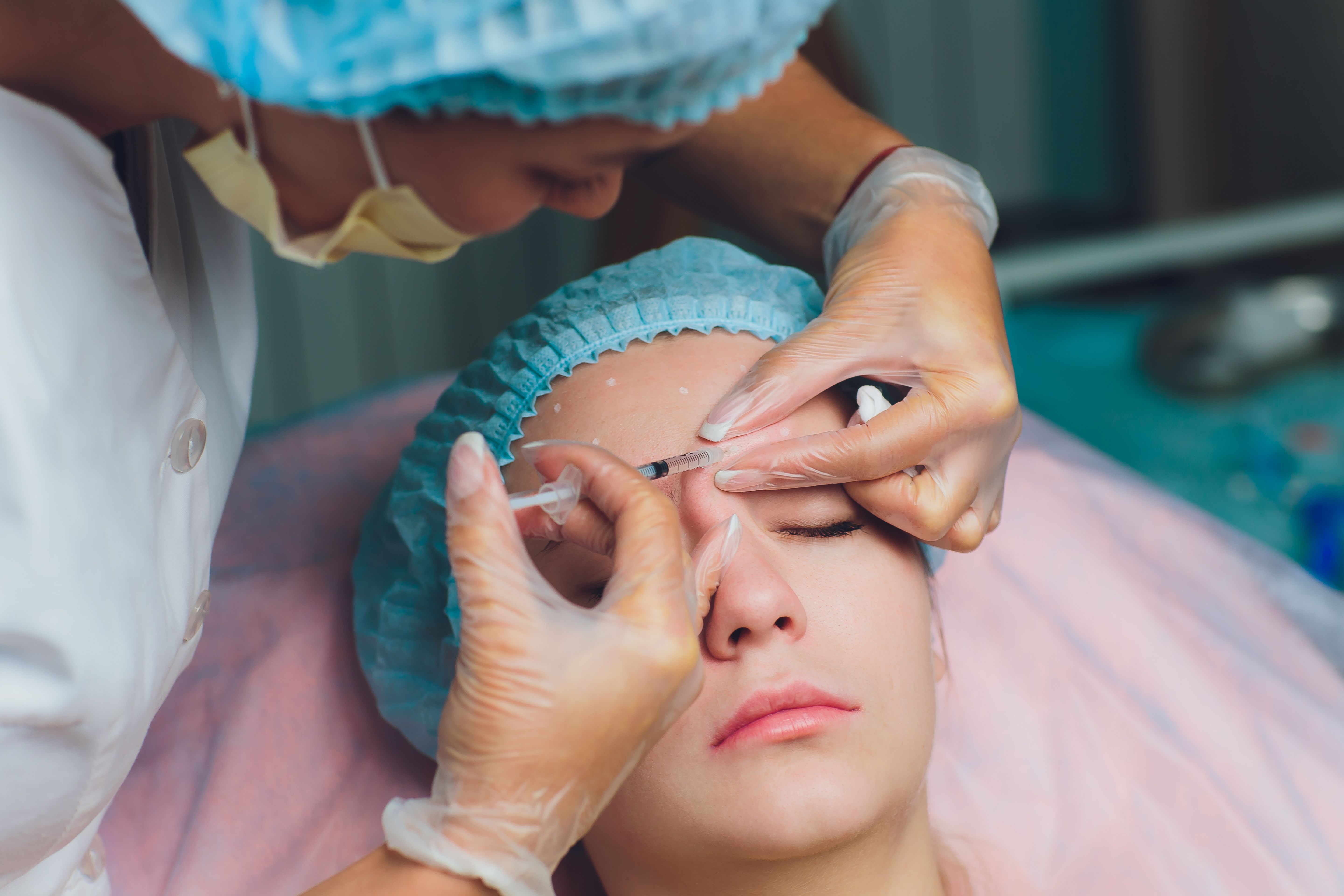- Case-Based Roundtable
- General Dermatology
- Eczema
- Chronic Hand Eczema
- Alopecia
- Aesthetics
- Vitiligo
- COVID-19
- Actinic Keratosis
- Precision Medicine and Biologics
- Rare Disease
- Wound Care
- Rosacea
- Psoriasis
- Psoriatic Arthritis
- Atopic Dermatitis
- Melasma
- NP and PA
- Skin Cancer
- Hidradenitis Suppurativa
- Drug Watch
- Pigmentary Disorders
- Acne
- Pediatric Dermatology
- Practice Management
- Prurigo Nodularis
- Buy-and-Bill
Article
How to apply the science of neuromodulators to practice
Author(s):
Suneel Chilukuri, M.D. presented on the science of neuromodulators at the October Maui Derm NP + PA Fall 2019 meeting in Asheville, N.C. Read insights gleaned from his presentation in this article.
(Евгений_Вершинин - stock.adobe.com)

Dr. Chilukuri

Neuromodulators are introductory cosmetic procedures for many dermatology practices. Offering neuromodulators allows aesthetic providers to connect with patients, wowing those patients with dramatic and consistent results and no downtime.
But like anything done in a cosmetic practice, neuromodulator treatments in the wrong hands can lead to disaster, according to dermatologic surgeon Suneel Chilukuri, M.D., of Refresh Dermatology in Houston.
RELATED: Botulinum and the brow
“It’s not just the lid droop that everybody commonly fears,” says Dr. Chilukuri who presented on the science of neuromodulators at the October Maui Derm NP + PA Fall 2019 meeting in Asheville, N.C.
A lot of people nowadays are offering neuromodulators off-label without fully understanding facial anatomy, neuromodulator product differentiators, and how and why individual toxins work, he says.
“When people are injecting around the mouth, we’ve seen issues where people can’t smile fully anymore, or they’re drooling. Similarly when people are injecting the depressor anguli oris – if they are just medial or don’t know the anatomy properly and are injecting in that general area – patients end up looking like they’ve had a stroke,” Dr. Chilukuri says. “On the other hand, we’re seeing patients who get incredible results with neuromodulators. And for many providers, neuromodulators are sort of the mainstay of cosmetic practice.”
WHAT NPS, PAS NEED TO KNOW
There are 4 FDA-approved neuromodulators for cosmetic indications:
- Onabotulinumtoxin A (Botox Cosmetic, Allergan),
- Abobotulinumtoxin A (Dysport, Ipsen),
- Incobotulinumtoxin A (Xeomin, Merz),
- Prabotulinumtoxin A (Jeuveau, Evolus)
“Botox has the most indications of any neuromodulator on the market, both for cosmetic purposes and for medical purposes. The others are approved cosmetically only for the glabellar area,” Dr. Chilukuri says.
RELATED: Jeuveau takes aim at aesthetic market share
Botulinum toxin A products work by blocking acetylcholine (Ach) release from presynaptic peripheral cholinergic nerve fibers, according to Dr. Chilukuri.
While results tend to be similar with all the approved neuromodulators, today’s products differ in how they’re manufactured, properly dosed and more.
“Dosage is really going to be dependent on your experience and what you’re trying to gain,” he says.
Some are taught to inject with 1cc dilution, which might be the ideal for a more specific, smaller treatment area. The standard 2.5cc dilution on the label for Botox, Xeomin and Jeuveau will likely treat a larger area, providing an effect approximately 2cm in diameter beyond the injection site, Dr. Chilukuri says.
In practice, diluting Dysport with 2.5cc can allow it to be different.
RELATED: Facial exercise accelerates Botox results
“Putting 0.1cc of Botox in a small area, you can get the same effect as putting 0.1cc of Dysport in the that area. But the unit numbers are different. The unit numbers for Botox would be 4 units in that injection point of 0.1cc but that’s equivalent in our practice to 12 units of Dysport,” Dr. Chilukuri said. “They both give about the same results. When injecting with a higher dilution, you can at least in theory get a broader spread of that neuromodulator.”
Another possible differentiator is anecdotal evidence that suggests Dysport and Jeuveau work faster, within 24 to 36 hours, than Botox or Xeomin, which begin to show signs of change within 48 hours, according to Dr. Chilukuri. However, he notes that clinical research has not validated these clinician claims.
The maximum effect for all four of the products is from two to two and a half weeks. And most last from three to four months, on average, he says.
Something that’s different about Xeomin is that it’s the only one of the four that does not have to be refrigerated, he says. In addition, Xeomin is the only neuromodulator that does not have a protein complex attached to it. Some will claim that it is a “naked molecule.”
WHEN TO AVOID USING NEUROMODULATORS
Injectable neuromodulators are relatively safe for most people, but they’re not for every patient. Among the drugs to interact with botulinum type A products are aminoquinolones. These drugs, including chloroquine and hydroxychloroquine, antagonize the “Botox effect” by inhibiting the binding or processing of toxin.
RELATED: Higher doses of neurotoxin last longer
Dr. Chilukuri always takes a full medical history and asks patients if they have any history of neurologic problems. He asks about Bell’s palsy, myasthenia gravis, Lambert-Eaton myasthenic syndrome and about muscular disorders, in general, as well as if patients have a family history of ALS, or Lou Gehrig’s disease.
“Sometimes these conditions can be unmasked by using neuromodulators,” he says.
Before injecting patients, providers also should make sure patients don’t need the muscles to function at full force. For example, mature patients may be using the frontalis muscles to raise their eyebrows to be able to see, he says.
IN THE PIPELINE
There are a few neurotoxins in the pipeline that could be close to FDA approval: DaxibotulinumtoxinA (DAXI, Revance) and Allergan’s Bonti.
Revance’s product is thought to last up to two times longer than current products, showing durations of four to six months and more in clinical trials.
RELATED: Neurotoxin news: The DAXI differentiator
“The question becomes is that dose dependent? Revance’s units sound like they’ll be double the number of units for Botox, Xeomin and Jeuveau. But how they’re describing it is it’s the same volume that’s going in. So, 0.1 is equal to 0.1, but it’s similar to Dysport where they’re calling it a higher number of units. So, 8 units in one injection point is going to give you a longer-term result than 4 units of Botox,” Dr. Chilukuri says.
DAXI also is unique aspect in that it’s the first neuromodulator that doesn’t use human albumin as a component; rather it uses a proprietary stabilizing peptide excipient.
Allergan’s Bonti is a faster-acting Botox, which works within 24 hours or less and has maximum effect within a couple of days. But it also lasts a much shorter time.
“We don’t know exactly how long but Allergan estimates between 30 to 40 days,” Dr. Chilukuri says.
DAXI might be best used for the patient that needs a quick result, for an event. Dr. Chilukuri says the marketing team for Allergan suggests Bonti might be used as introductory Botox, where the patient can test the waters with the shorter-duration option.
“The way I see Revance being used in my practice is for the patients that ‘burn through’ Botox faster. Whether they’re athletes or they’re just able to regenerate presynaptic acetylcholine faster, we don’t know why it’s happening, but I’m excited to try Revance’s product for those patients,” he says.
Disclosures:
Dr. Chilukuri has worked as a consultant and speaker for Alastin, Aerolase, Allergan, Bellus, BTL, Cynosure, Dominion Lasers, Eclipse, Galderma, InMode, Lutronic, Merz, PCA Skin, Revance, Sinclair, Sente, Skin Medica, Theravant, Under Skin, and ZO Skin.






